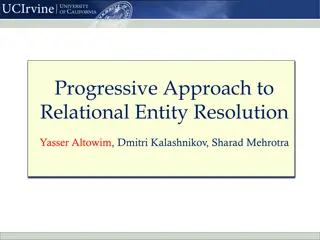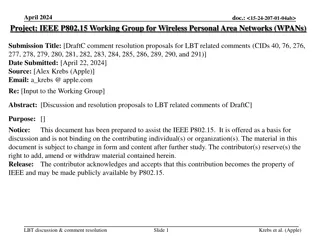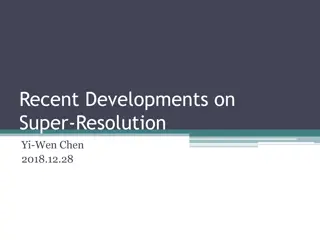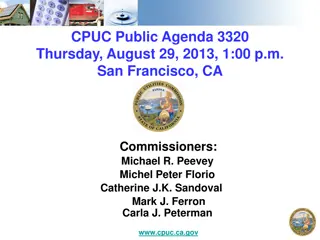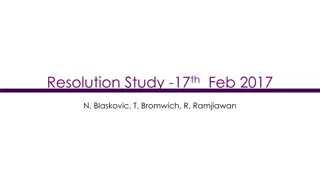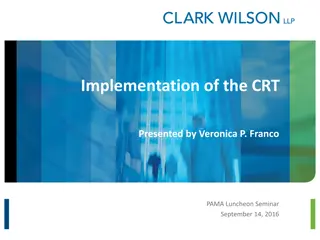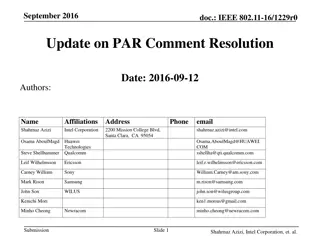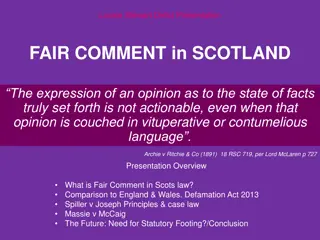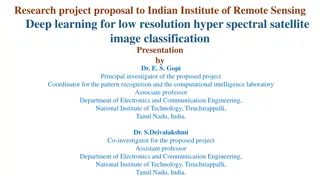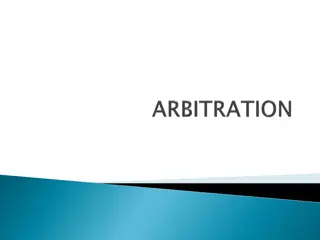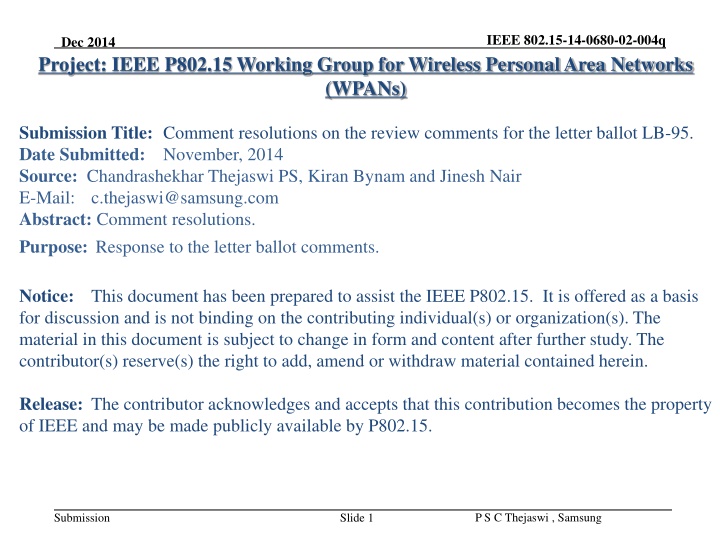
Wireless Personal Area Networks IEEE 802.15 Comment Resolutions Dec 2014
"Explore the resolutions for comments on the letter ballot LB-95 within the IEEE P802.15 Working Group for Wireless Personal Area Networks. Review changes proposed for MAC symbol time calculations and symbol durations in ULP-TASK PHY. Adjustments made to frequency band channels discussed. Find insights into specific frequency bands such as 863-876 MHz and 951-958 MHz." (291 characters)
Download Presentation

Please find below an Image/Link to download the presentation.
The content on the website is provided AS IS for your information and personal use only. It may not be sold, licensed, or shared on other websites without obtaining consent from the author. If you encounter any issues during the download, it is possible that the publisher has removed the file from their server.
You are allowed to download the files provided on this website for personal or commercial use, subject to the condition that they are used lawfully. All files are the property of their respective owners.
The content on the website is provided AS IS for your information and personal use only. It may not be sold, licensed, or shared on other websites without obtaining consent from the author.
E N D
Presentation Transcript
IEEE 802.15-14-0680-02-004q Dec 2014 Project: IEEE P802.15 Working Group for Wireless Personal Area Networks (WPANs) Submission Title: Comment resolutions on the review comments for the letter ballot LB-95. Date Submitted: November, 2014 Source: Chandrashekhar Thejaswi PS, Kiran Bynam and Jinesh Nair E-Mail: c.thejaswi@samsung.com Abstract: Comment resolutions. Purpose: Response to the letter ballot comments. Notice: This document has been prepared to assist the IEEE P802.15. It is offered as a basis for discussion and is not binding on the contributing individual(s) or organization(s). The material in this document is subject to change in form and content after further study. The contributor(s) reserve(s) the right to add, amend or withdraw material contained herein. Release: The contributor acknowledges and accepts that this contribution becomes the property of IEEE and may be made publicly available by P802.15. P S C Thejaswi , Samsung Submission Slide 1
IEEE 802.15-14-0680-02-004q Dec 2014 Pg. No ClauseLn. No. Reviewer Comment Proposed Change no. Please mention how MAC symbol time is chosen which is used in calculation of length of slots , back off slots etc Kindly mention MAC symbol timing for TASK proposal of clause 30 1069 Kiran Bynam 3 5.1 2 Resolution: Revised Insert the following paragraph and the table in sub-clause 5.1. 5.1.1 MAC Symbol duration for ULP-TASK PHY For ULP-TASK PHY, the symbol duration parameters for MAC and PHY timing parameters, for different bands of operation shall be as given in the Table (insert the reference of the table) P S C Thejaswi , Samsung Submission Slide 2
IEEE 802.15-14-0680-02-004q Dec 2014 Table XXXX ULP-TASK symbol duration used for MAC and PHY timing parameters Symbol duration (??) 64 Frequency band (MHz) Chiprate (Mcps) 433.050-434.790 0.25 470-510 0.25 64 779-787 0.6 26.667 863-876 0.6 26.667 902-928 0.6 26.667 950-956 0.6 26.667 2400-2483 1 16 P S C Thejaswi , Samsung Submission Slide 3
IEEE 802.15-14-0680-02-004q Dec 2014 Pg. No ID Clause Ln. No. Reviewer Comment Proposed Change Frederik Beer The Band 863-876 has only 3 channels, but could serve a lot more. 1074 7 8.1.2.14 16 Adjust number of channels. Resolution: Revised In Table 2 (Pg. 7 ), in the cell corresponding to 5throw (band 863-876 MHz ), and 3rd col.(col. TotalNumChan ) replace 3 by 5 . P S C Thejaswi , Samsung Submission Slide 4
IEEE 802.15-14-0680-02-004q Dec 2014 Ln. No. ID Reviewer Pg. No Clause Comment Proposed Change Check the 951 Mhz band. I am not sure if it actually goes from 951-958. And the First centerfreq is 951 which is the lower boundary. But then again I am no expert in Japan bands. Frederik Beer Get someone who knows this band. 1075 7 8.1.2.14 16 Resolution: Revised In Table 2 (Pg. 7 ), replace the 7th row (band 951-958 MHz) with the following row: 950-956 2 3 951 P S C Thejaswi , Samsung Submission Slide 5
IEEE 802.15-14-0680-02-004q Dec 2014 Ln. No. ID Pg. No Clause Reviewer Comment Proposed Change No text is allowed to follow a clause title, it must be in a subclause. Either delete the text as it is unnecessary, move it to another location or add a sub-clause title 30.1 General. 1281 11 30 2 James Gilb Resolution: Revised In Pg. 11, Ln. 2: Immediately after title of the clause 30, insert a new sub-clause 30.1. under the title General . In this sub- clause, place the introduction part. P S C Thejaswi , Samsung Submission Slide 6
IEEE 802.15-14-0680-02-004q Dec 2014 Comments on MCS/MFI/CFI ReviewerPg. No. Clause Ln. no. Comment Proposed Change No Is a "Modulation Format" exactly the same thing as a "Modulation and Coding Scheme"? Yes it is, and so we should not introduce a new term; use the nomenclature of the standard being amended Benjamin A. Rolfe 30.1.2.2 .3 Use "Modulation and Coding Scheme" instead of MFI. 1290 12 24 "The MFI field specifies the type of modulation employed" is not a technically correct or complete description of the field. What you probably mean is that the MFI field indicates the Modulation and Coding Scheme used to encode the PHY Payload (a fact I guessed since the text does not specify to what part of the PPDU the MFI applies to, or even if it applies to the PPDU at all). Change field name to "Modulation and Coding Scheme" to be consistent with the standard; Change to read "The Modulation and Coding field shall be set to the MCS used to encode the PHY Payload" and specify what MCS is used to encode the PHR. Benjamin A. Rolfe 30.1.2.2 .3 1291 12 24 Discuss if this can be merged somehow or find more distinctive names. Frederik Beer I find the distinction between MCS and Modulation format a little irritating. 1079 15 30.4.2 15 P S C Thejaswi , Samsung Submission Slide 7
IEEE 802.15-14-0680-02-004q Dec 2014 Resolution: Revised MFI/CFI fields have been merged into a single field MCS. References to MFI/CFI are replaced with MCS. In Pg. 12, replace Figure 8 with the following figure: Pg. 12-13, delete sub-clauses 30.1.2.2.3 and 30.1.2.2.4 and create a sub-clause under the title MCS field . Add the following text The MCS field specifies the modulation and the coding scheme applied on the PSDU. There are four modulation formats and two FEC mechanisms provided. Valid values of the MCS field and the corresponding mapping of the modulation and coding schemes are given in Table 5. P S C Thejaswi , Samsung Submission Slide 8
IEEE 802.15-14-0680-02-004q Dec 2014 In Pg. 13, replace Table 5 with the following table: MCS field PHR8,PHR9,PHR10 Modulation format FEC (0, 0, 0) 1/1-TASK BCH (1, 0, 0) 2/4-TASK BCH with interleaving (0, 1, 0) 3/8-TASK BCH with interleaving (1, 1, 0) 5/32-TASK BCH with interleaving (0, 0, 1) 1/1-TASK BCH+SiPC (1, 0, 1) 2/4-TASK BCH+SiPC (0, 1, 1) 3/8-TASK BCH+SiPC (1, 1, 1) 5/32-TASK BCH+SiPC Change the caption for table to Table 5 Mapping of the MCS field Delete the sub-clause 30.4.2 and the Table 7. P S C Thejaswi , Samsung Submission Slide 9
IEEE 802.15-14-0680-02-004q Dec 2014 In Pg. 15, sub-clause 30.4.1, replace the entire text with the following text MCS identifier is determined by the higher layers based on the data rate requirements, as mentioned in 6.3.1. MCS identifier specifies modulation and coding schemes to be applied on the PSDU. In any given frequency band of operation, eight MCS identifiers (0-7) are defined based on the data rates. First four identifiers specify mandatory modes and the last four identifiers specify optional modes. When MCS identifier takes values from zero to three (MCS identifier = 0, 1, 2, 3), BCH with interleaving shall be used for FEC, otherwise (MCS identifier = 4, 5, 6, 7), concatenation of BCH with interleaving and SiPC shall be used for FEC. MCS identifiers (0-3) are mandatory and MCS identifiers (4-7) are optional. The MCS identifier and the corresponding data rates for different frequency bands are provided in Table 7, Table 8 and Table 9. Also, for each MCS, the parameters such as constellation size (Q), modulation order (M), spreading sequence length (L), and spreading factor (SF) are given in these tables. P S C Thejaswi , Samsung Submission Slide 10
IEEE 802.15-14-0680-02-004q Dec 2014 Pg. No ID Reviewer Clause Ln. no. Comment Proposed Change Just have a table that has the bit, 1 or 0, and the corresponding spreading code. All the c's and fancy math notation distract from the description. Plus the figure is essentially useless. It is almost as if you don't want people to understand this, so it is expressed in the most obtuse manner possible. That or this is an academic research project that no one has thought of implementing as an actual product. 1285 James Gilb 14 30.2 22 Resolution: Revised . Retained only one preamble and SFD spreading sequence as a resolution to CID 1298. New table is provided below. In Pg. 14, delete Figure 11, and it s the sentence referring to it in Ln. 22. Replace Table 6 with the following table P S C Thejaswi , Samsung Submission Slide 11
IEEE 802.15-14-0680-02-004q Dec 2014 Pg. No ID Reviewer Clause Ln. no. Comment Proposed Change merge 30.5.2.1 with its parent subclause,and also omit duplicated sentences. Also maintatin consistency in the notation. There is no need for this subtitle, since it is already mentioned in 30.5.2. Also, ensure notation are consistent. Especially, w.r.t. the set C. 1060Kiran 23 30.5.2.1 29 Bynam Resolution: Revised In Pg. 23, delete sub-clause 30.5.2.1, and the sub-clause 30.5.2.2. Replace the text in 30.5.2 with the following text: Ternary sequence spreading is performed by a process of mapping each data symbol to a unique sequence of chips. The mapping is determined by the modulation format specified by the MCS field. The parameters for different modulation formats are given in 30.5. For a modulation format with the constellation size, Q, and the spreading sequence length, L, this stage maps data symbols from ? = {0,1, ,? 1} to a set of L-length ternary sequences,?. The following sub-clauses outline the data- symbol-to-chip mapping for different modulation formats. Chip transmission order: For an L-length chip-sequence,??= ??0 ??(1) ??? 1 , ??0 shall be transmitted first, and ??? 1 shall be transmitted last. Change the sub-clauses 30.5.2.1.1 -30.5.2.1.4, to H4 heading. P S C Thejaswi , Samsung Submission Slide 12
IEEE 802.15-14-0680-02-004q Dec 2014 Review er Pg. No Claus e Ln. no. Proposed Change ID Comment There is no baseband signal in the standard. A compliant implementation is not required to create that baseband signal, only the RF signal is specified. The inclusion of this detail, as with the ASK with negative amplitude (no such thing exists at RF, all amplitude is positive, but it may have a relative phase difference) in the previous subclause cast a shadow on this entire effort. The goal is to create an RF waveform, not a baseband waveform. Delete the baseband signal representation as it is meaningless. James Gilb 1288 28 30.8 11 Resolution: Revised In Pg. 28, delete the entire text in the sub-clause 30.8 with the following text: The modulated PPDU signal is represented as ????? ???? = ? ?(?)? ? ??? ?? ???(??? + ?) ?=1 where ?(?) 1, 0,1 are the chips of PPDU ?? ?? is the chip duration ????? is the number of chips in the PPDU ?? is the angular frequency of the carrier ? [0,2?] is the random phase. P S C Thejaswi , Samsung Submission Slide 13
IEEE 802.15-14-0680-02-004q Dec 2014 Review er Pg. No Claus e Ln. no. Proposed Change ID Comment Chandras hekhar Thejaswi PS Appropriately mention the transmit PSD limits in 433 and 470 MHz bands. The bandwidths of the channels in each of these bands are mentioned as 400KHz. incorporate the change 1104 29 30.9 18 Resolution: Revised In Pg. 29, sub-clause 30.9.1, Replace the Table 18 with the following table: Frequency range f fc > 0.5 MHz Relative limit -20 dB Absolute limit -20 dBm Replace the sentence in Ln. 22-23 (Pg. 29) with the following sentence: For the relative limit, the reference level shall be the highest average spectral power measured within 250 kHz of the carrier frequency. P S C Thejaswi , Samsung Submission Slide 14
IEEE 802.15-14-0680-02-004q Dec 2014 Revie wer Pg. No Clau se Ln. no. Proposed Change ID Comment either specifically state behavior that LQI is used for or delete LQI requirement 1192Pat 31 30.9.11 2 LQI is required but not used in any mandatory behavior Kinney Resolution: Revised Replace the text in the subclause 30.9.12 with the following paragraph: The LQI measurement is a characterization of the strength and/or quality of a received packet. The measurement may be implemented using an appropriate signal-to-noise ratio estimation technique. The LQI measurement shall be performed for each received packet. On receipt of every packet, LQI of the packet should be shared with the MAC layer. The minimum and maximum LQI values (0x00 and 0xff) should be associated with the lowest and highest quality compliant signals detectable by the receiver, and LQI values in between should be uniformly distributed between these two limits. The LQI value should be used for determining the supported data rate in PHY layer. P S C Thejaswi , Samsung Submission Slide 15
IEEE 802.15-14-0680-02-004q Dec 2014 Comments on FEC/multiple FECs Pg. No Claus e Ln. no. No. Reviewer Comment Proposed Change Timothy Harrington, James Gilb, M. Lynch 1015, 1239, 1301 There is no need to define a new FEC as there are already many defined in 802.15.4. The new FEC does not enable lower power than the existing FECs Replace the BCH and SiPC with a single FEC from the base standard. 16 30.4.3 2 Resolution: Revised Please see our presentation on FEC refer to the document DCN 15-15-0664-01-004q A presentation is prepared to defend the inclusion of two FECS. P S C Thejaswi , Samsung Submission Slide 16
IEEE 802.15-14-0680-02-004q Dec 2014 Comments on 5C requirement of distinct identity Pg. No ClauseLn. Proposed Change No. Reviewer Comment no. The draft does not meet the 5C requirement of distinct identity. There are already low power PHYs defined in 802.15.4, the O- QPSK PHY, LRP UWB and BPSK PHY all enable power usuage at or below the proposed TASK PHY. The TASK PHY does not take advantage of ASK modulation (it requires phase coherency in the transmitter) nor is it a constant envelope modulation (e.g., FSK) and so the resulting designs will end up even higher power than the currently defined PHYs. Delete Clause 9 and references to the ULP TASK PHY. 1013, 1237, Timothy Harrington, James Gilb, M. Lynch 11 30 1 1299, P S C Thejaswi , Samsung Submission Slide 17
IEEE 802.15-14-0680-02-004q Dec 2014 Resolution: Rejected Meets the requirements of PAR, which are unique: Support of multiple data rates in the specified bands up to 1Mbps Power consumption <15 mW (as per PAR) Support in the design of ultra low power receivers, like SRR based receivers etc. Support for both coherent and non-coherent receivers, due to the employment of spreading based on ternary sequences. ULP capability of TASK: Supports ULP receivers. Advanced transmitter designs are available which can ensure ultralow power consumption. P S C Thejaswi , Samsung Submission Slide 18
IEEE 802.15-14-0680-02-004q Dec 2014 Pg. No Ln. no. No. Reviewer Clause Comment Proposed Change Delete this clause, or replace with one that specifies a PHY that offers the capability of one order of magnitude lower power operation compared to existing PHYs This clause does not meet the PAR requirements of specifying a PHY with lower power capabilities compare to those that are already specified in 802.15.4 1289 Tim Godfrey 11 30 1 Resolution: Rejected This clause meets all the requirements of PAR. For more information, please refer to our recent presentation: slide 24 of DCN IEEE 802. 5-13-0705-00-004q. P S C Thejaswi , Samsung Submission Slide 19
IEEE 802.15-14-0680-02-004q Dec 2014 Comments on the co-existence document Pg. No Ln. no. Proposed Change No. Reviewer Clause Comment 15-14-0565-00-004q Coexistence Assurance Document: No supporting documentation to support coexistence of the TASK PHY with existing 802. PHYs operating in collocated frequency bands Produce supporting documentation Steve JILLINGS 1016 - - - If the 15-14-0565-00-004q-coexistence- assurance-for-ieee-802-15-4q.docx document is listed in this paragraph as a reference document, the reference document states in paragraph 2 the following 'The Ultra Low Power (ULP) GFSK and ULP TASK Physical Layers defined in amendment 802.15.4q are substantially similar to the Physical Layers defined in amendments 802.15.4k and 802.15.4p. The bands used are a subset of the union of the bands defined in those amendments. The coexistence assurance documents defined for 15.4k and 15.4p provide adequate analysis for 15.4q environment.' if the TG4q ULP TASK and ULP GFSK PHYs are substantially similar to the PHYs defined in amendments 802.15.4k and 802.15.4p then how do the ULP TASK and ULP GFSK differ enough from all previous 802.15.4 PHYs to justify becoming new 802.15.4 PHYs? Make the appropriate changes to the coexistence document to resolve this issue or proceed no further with the 802.15.4q draft standard. Annex C Bibliogra phy 1187 46 2,3, 4 Mike McInnis P S C Thejaswi , Samsung Submission Slide 20
IEEE 802.15-14-0680-02-004q Dec 2014 Resolution: Revised 802.15.4q PHY and PHY defined in 802.15.4p /802.15.4k are completely different: 802.15.4p/4k use GMSK, C4FM, QPSK, DQPSK, DSSS-DPSK, DSSS-BPSK, whereas 802.15.4q employ TASK (ternary spreading with ASK) and GFSK Further, our standard operates in the following set of new bands not defined in 15.4p/4k : 433MHz, 470-510 MHz, 779-787MHz and 863-876 MHz UWB PHY of 802.15.4 is also substantially different: 802.15.4 UWB PHY does not operate in any of the bands specified in this std. Coexistence assurance document will be prepared for ULP-TASK PHY. P S C Thejaswi , Samsung Submission Slide 21

